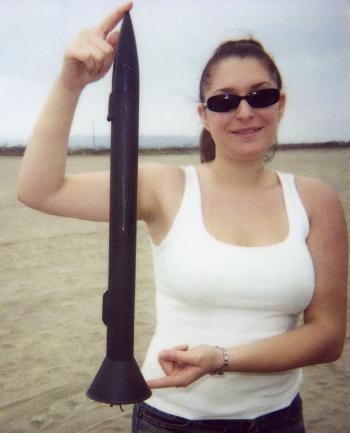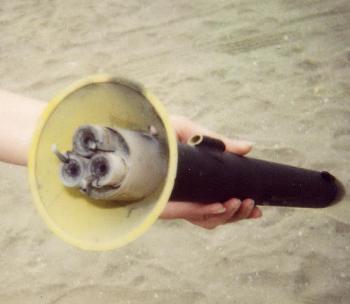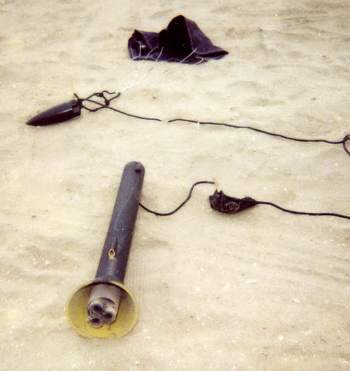Scratch Funnel Vision Original Design / Scratch Built
Scratch - Funnel Vision {Scratch}
Contributed by Larry Brand
| Manufacturer: | Scratch |
 Brief:
Brief:
Funnel Vision was designed as part of an effort to create a cluster rocket giving fully stable flight in the event of partial ignition failure. It was built as a finless design inspired by David Roy's "Drag Demon" as described in his July 2001 Sport Rocketry article. The rest of the rocket is identical to the 2BZ cluster design that I presented on this website last year.
Construction:
Funnel Vision is built using the following components:
- 18" 38mm Estes Body tube
- 3 x 4" sections of 18mm Estes motor tubes with motor stops and Estes motor hooks assembled in the usual way
- One black Estes 38mm ogive nose cone, ballasted with split-shot fishing sinkers and 5 min. epoxy to a final weight of 50g.
- One 3.75" (4" nominal) plastic funnel
- 15" nylon Top Flight chute with 8' of para cord with a size small Kevlar protector pad as recovery system
 Assembly is about as simple as it gets, especially for a cluster rocket. The plastic funnel is carefully cut down to about 2" in depth, until the body tube almost slides through it. Use sandpaper to complete the fitting process, so the body tube snugly slides in, then epoxy it in place, flush with the bottom of the body tube, taking care to insure perfect vertical alignment (I kept the assembly vertical, and aligned with a window frame as the tack glue job dried, then turned it over and gobbed on some more epoxy to hold the funnel in place). The three 18mm Estes motor tubes are assembled and then epoxied together in triangular array. When dry, they are slathered with epoxy and slid into the aft end of the body tube. Be sure to plug all spaces between the motor tubes and the hull with bits of tissue and gobs of epoxy -- to insure ejection charge pressurization. That's it -- Funnel Vision is done. I attached the recovery system with a knot anchored through the body tube 3" from the top, and covered with a split BIC pen cap. See photos before/after launch, and aft close-up.
Assembly is about as simple as it gets, especially for a cluster rocket. The plastic funnel is carefully cut down to about 2" in depth, until the body tube almost slides through it. Use sandpaper to complete the fitting process, so the body tube snugly slides in, then epoxy it in place, flush with the bottom of the body tube, taking care to insure perfect vertical alignment (I kept the assembly vertical, and aligned with a window frame as the tack glue job dried, then turned it over and gobbed on some more epoxy to hold the funnel in place). The three 18mm Estes motor tubes are assembled and then epoxied together in triangular array. When dry, they are slathered with epoxy and slid into the aft end of the body tube. Be sure to plug all spaces between the motor tubes and the hull with bits of tissue and gobs of epoxy -- to insure ejection charge pressurization. That's it -- Funnel Vision is done. I attached the recovery system with a knot anchored through the body tube 3" from the top, and covered with a split BIC pen cap. See photos before/after launch, and aft close-up.
 Flight:
Flight:
The best motors are Estes C6-5, which will give a great boost ("E18-power") to 7-800' or more, and a pretty decent flight even if one motor fails to light ("D12-power"). C6-7 works fine too, as long as all three motors light. For cluster ignition I use 14" double ended alligator clip test wires from Radio Shack, with 1" of the middle stripped of insulation -- by attaching the bare middle section of one of these to each end of another, 4 motors can be ignited from one set of 12 volt launch pad leads (you need two of these set ups). Or, if I'm lazy and its a slow launch day, I just borrow the two neighboring launch clips on our club rack. Its important for cluster models to test continuity on all motors before firing. The 15" recovery system is perfect, and anyway -- hey, its finless, so no fins to break off. For 2 calibre stability, CG should be 12.25" from the tip, or 10.5" from the base of the funnel. I hand-solved the Barrowman equations for CP determination using just nose cone, body and a transition section consisting of the "funnel-fin". Research continues.
Summary:
PROs: As near as I can tell, this is the only finless cluster model I've heard of, except for the scale renditions of the Russian N-1 moon rocket by Andy Woerner and others. It is the easiest to build, for sure, and appears fully stable flying with 2 of 3 C6-5s lit. No worry about losing a fin. Cheap access to E18 power. Different and looks cool.
CONs: For its size, it needs a fair amount of nose weight to accommodate the forward CP of the finless design. I'm thinking of scaling it up 2x to fly on single G69 Pro38 power using a 3" mailing tube hull and 8" funnel "fin."
 |
 |